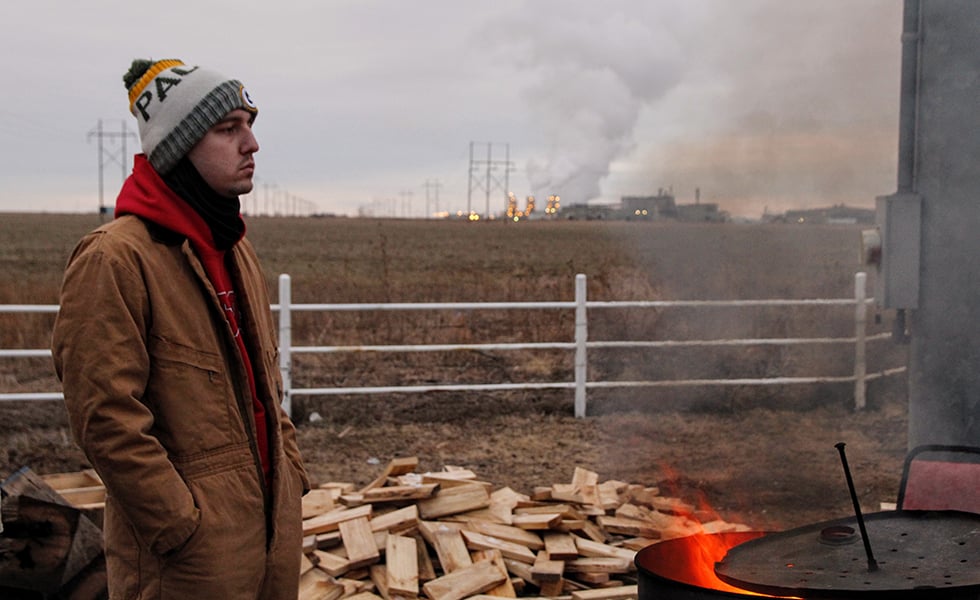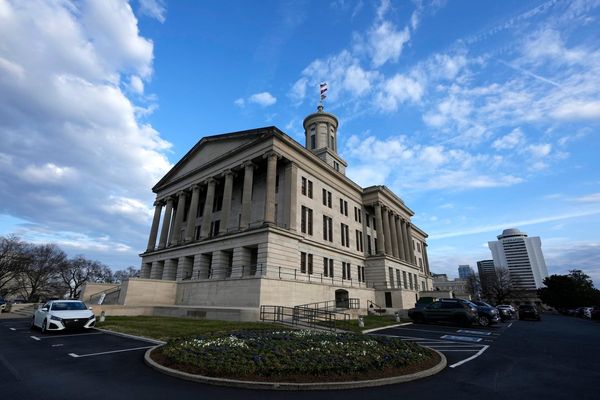It’s a February evening in the Texas Panhandle, and it’s cold as hell. Five men stand on the shoulder of Highway 136 northeast of Amarillo, huddled around a fire in a 55-gallon oil drum. Patches of snow linger from a morning flurry, and barren fields cut none of the whipping wind. In the distance, a power plant and a copper refinery dot the sparse horizon.
On a normal day, the men might be working at the refinery, turning 2,000-degree molten metal into thick slabs and coils suitable for manufacturing. Instead, for the past four months, they’ve taken shifts standing along that highway, cheering as passing tractor-trailers honk in support, or jeering as a few colleagues arrive to go to work. In the GOP stronghold that is the Panhandle, these are union workers, and they’re on strike.
“Whether we’re out here two more months or five more months, we’re all gonna stick together,” says Thaland Roberts, a 55-year-old bear of a man who’s put in 31 years at the copper facility. Roberts’ father-in-law and uncle worked at the plant, and now his 30-year-old son does too. “I love my job,” he says. “I hate the company that owns it.”
Roberts is one of about 150 United Steelworkers (USW) members on strike from the Amarillo copper refinery, which is owned by Tucson-based Asarco LLC. More than 1,500 additional workers are on strike at the company’s mines in Arizona. In 1999, Asarco was bought by Grupo México, a massive Mexico City-based mining and railroad conglomerate that’s played hardball with its unionized American workers. Roberts and his coworkers haven’t seen a raise in a decade, and now, the company wants to freeze pensions and hike employee contributions to health insurance. That decision led to the October strike, a labor conflict that’s now squeezing hundreds of working families.
“It’s tough,” says Tannen Andrews, a baby-faced 23-year-old who monitors acid and chemical mixtures at the refinery. Andrews has picked up part-time work at Walmart, and the union helps him pay monthly bills and provides emergency-only health insurance after Asarco cut off coverage. Still, it’s hard to support his 3-year-old daughter and fiancée, who’s in school studying physical therapy. “Kids need clothes, and I can’t afford that right now,” Andrews says, jamming his hands into the pockets of his insulated coveralls. “She’s eating more too, and I can’t spend what I’d want on groceries.”
Standing next to Andrews is his father, Jerry, who also works at Asarco. (The company gives hiring preference to employees’ family members.) Four years ago, when Andrews found out his fiancée was pregnant, Jerry encouraged him to apply at Asarco. “Now I look back and it’s like, ‘Damn, did I lead him in a wrong direction?’” Jerry says. After years in construction, driving a forklift at Asarco for $20 an hour is the best job Jerry’s ever had—but he thinks the company’s owners want to change that. “It’s just greed,” he says, lighting a cigarette. “They want to break the union and bring in new people they can pay less.”

Asarco is an institution in Amarillo. For 53 years, the company ran a zinc smelter in the area, before closing that facility in 1975 and opening the copper refinery the following year. The firm’s environmental record is atrocious: In 1992, Asarco settled a lawsuit over emissions from the former zinc plant, and for a century, the company ran a smelter in El Paso that spewed lead, arsenic, and other contaminants over residents and their neighbors in Ciudad Juárez. Still, the company provided middle-class wages and benefits to working Amarilloans for decades.
“This was a top place to work in the whole Panhandle,” says David Devore, who’s worked 25 years at the copper refinery. “Ever since Grupo took over, everything changed.”
Grupo México is Mexico’s largest mining corporation and one of the biggest copper producers in the world. Its majority owner and CEO is Germán Larrea Mota Velasco, whose net worth of nearly $17 billion makes him Mexico’s second-richest man. In 1999, Larrea bought Asarco, but he temporarily lost control in the mid-aughts when the company entered a long and complex bankruptcy proceeding. When the dust cleared in 2009 and Larrea regained ownership, the company had shed millions in asbestos and environmental liabilities, and Asarco’s highly profitable copper mines in Peru had been spun off into a separate entity under Grupo México. In the first nine months of last year, Grupo declared a whopping $1.2 billion in profits. But the company is producing copper more cheaply in South America than in Arizona and Texas—something the firm aims to remedy.
During contract negotiations last year, union officials say, the company went to war on workers’ pay and benefits. Asarco, which offered a minuscule wage increase for a minority of workers, moved to more than double health insurance costs and gut so-called copper bonuses—a quarterly pay-out that workers receive based on the metal’s selling price. Asarco also wants to freeze pension contributions without a compensatory 401(k) match. The union refused, but officials say the company hasn’t seriously considered any counter proposals.
John Saavedra, a furnace operator who’s worked 13 years at Asarco and serves as the USW local president, says that in the last round of negotiations in November, the company dismissed the union’s offer after about 15 minutes. Meanwhile, Asarco has implemented the disputed contract and is using strikebreakers—“scabs,” in union parlance—to run some of its Arizona mines. (In Amarillo, a handful of scabs are working, but strikers say it’s too few to produce much.) José Loya, the USW’s district representative, calls the process “the worst negotiations [he’s] ever seen.”
Thanks to the company’s intransigence, there may not be any progress until the federal National Labor Relations Board (NLRB) rules on the union’s complaints alleging unfair bargaining practices. That timeline is uncertain.
In Arizona, multiple members of Congress and local officials have voiced support for the strike. Politically, the Texas workers are on their own: Amarillo city officials, along with retiring Republican U.S. Representative Mac Thornberry and both U.S. senators, have stayed silent.
Asarco and Grupo México did not respond to the Observer’s calls or emails, but a recent presentation for investors helps explain the company’s views. To stay sustainable, the document reads, Asarco “must modify its current labor practices.” The company goes on to lament that the union called a strike “despite the offer of salary increases for qualified workers and ongoing training for workers to increase their skills and knowledge to grow within the industry.” The firm says it remains committed to its “long history of boosting the economies of Arizona and Texas.”
Bullshit, labor advocates say. “You’re looking at a very militant employer—an employer that doesn’t appear interested in reaching a deal,” says Rick Levy, president of the Texas American Federation of Labor and Congress of Industrial Organizations (AFL-CIO). Levy cautioned that Trump’s NLRB may rule against the union, opening a pathway for the company to legally hire permanent replacement workers.
Still, Levy’s heartened that the union dared to strike at all. He sees the fight in Amarillo as part of a larger trend in labor: In 2019, there were more major work stoppages than in any year since 2001.
“You can’t look at this in isolation from thousands of teachers walking out in places like West Virginia … The level of worker activity is many orders higher than it’s been in any recent period,” Levy says, adding that donations for the USW have been pouring in from other unions, including the United Auto Workers who struck in Arlington last year. “There’s this real understanding that when they’re standing up in Amarillo, they’re really standing up for all of us.”

Kerri Wilkinson is standing up for three generations of her family. One of few women working at the copper refinery, the 26-year-old was preceded by her grandfather and father, who retired after 40 years at Asarco. Her dad participated in both of the most recent strikes at the copper plant, in 2005 and 1980. Though it’s her first strike, Wilkinson’s among the leaders: She’s running a food pantry for strikers at the local union hall, doling out canned goods, diapers, and baby wipes. “We’re not asking for unreasonable things,” she says. “We’re asking that they don’t take what we worked for.”
For Wilkinson, getting hired at Asarco was a springboard into something like a middle-class lifestyle. “I never thought I could have a job like this, making what I make, without a college degree,” she says. Before, Wilkinson worked as a bartender at trucker joints off I-40—jobs that offered inconsistent pay and no benefits. Now she makes $19 an hour. Even with three elementary-age sons to care for, it’s enough to support ambitions: This year, she planned to use six months’ savings plus her tax return to put a down payment on a house. Then, the strike happened. Her savings are gone now, and she expects the tax return will vanish too. She’ll just have to keep renting.
Still, when I ask how much longer Wilkinson’s willing to strike, she gives the same answer as every other worker I spoke to. “As long as it takes.”
Read more from the Observer:
-
San Antonio Embraces Mandaean Refugees: If the Mandaean religion survives, it will be partly because of the refuge it found in Central Texas.
-
1,500 Nueces County Voters Were Wrongly Sent Letters Demanding Proof of ID: A big mistake in the lead up to primary voting underscores the anxiety around misinformation on elections and barriers to voting.
-
With Coal Plants Offline, the Air in Central and East Texas Has Cleared: After three plants shut down in late 2017, legal air pollution in Texas fell by 150,000 tons.







